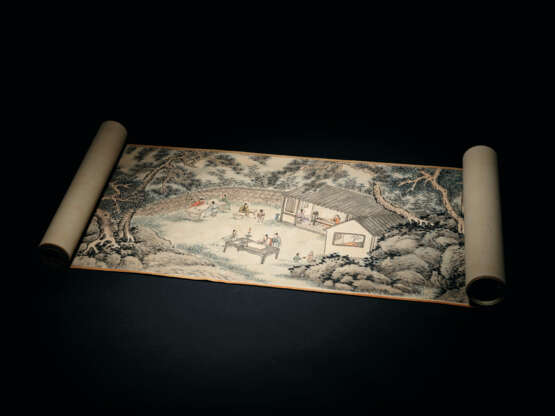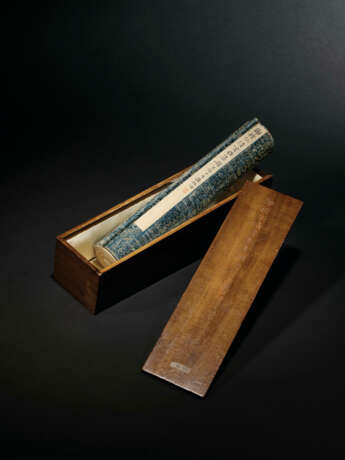ID 770801
Los 823 | XIE SHICHEN (1487-1567)
Schätzwert
HKD 8 000 000 – 10 000 000
Scholarly Gathering till Twilight
Handscroll, ink and colour on paper
29.8 x 127.5 cm. (11 3⁄4 x 50 1⁄4 in.)
With two seals of the artist
Inscribed, signed and dated spring, renzi the thirty-first year of the Jiajing period (1552), with three seals of the artist
Colophons by Zhou Tianqiu (1514-1595), Wen Peng (1498- 1573), Wen Jia (1501-1583), Wang Xi, Wang Xu, Zu Wu, Zhan Xianzhang, Ye Kun, Xu Chu, with a total of twenty-one seals Frontispiece by Wen Zhengming (1470-1559), with two seals
Six collector’s seals: four of Zhang Keyuan (1862-1930) and two of Sun Zutong (1888-1940)
Titleslip by Sun Zutong, with one seal
Accompanied by a wooden box incised with the titleslip details and a seal
Literature
Zhu Fengtai, Notes on Paintings Appreciation, in Complete Compendium of Chinese Painting and Calligraphy, Vol.10, Shanghai Painting and Calligraphy Publishing, Shanghai, October 1993, p.986.
Shanghai Museum ed., Seals and Signatures of Chinese Calligraphers and Painters, Cultural Relics Publishing House, Beijing, December 1987, pp. 1531-1532, pl.28 (seal of Xie Shichen); pp.161, 163-164, pl.14 and 67 (seal and signature of Wen Peng).
Post lot text
Refinement of the Wu School –A Legacy of Xie Shichen’s Scholarly Gathering till TwilightEver since the legendary gathering hosted by the great Jin calligrapher Wang Xizhi at the Orchid Pavilion on the third day, third month and the ninth year of the Yonghe period (353), “elegant gathering” like this one had become a standard practice for the later generations of literati.On the twelfth day, second month, thirty-first year of the Jiajing period (1552), the Viceroy of Water Transport Guo Jingshan invited the celebrities of the Wu area for a literati gathering. According to the image and inscriptions of Scholarly Gathering till Twilight, it was a spectacular feast that lasted into the night. Wen Peng (1498-1573) suggested to commemorate the joyful event and eventually, Xie Shichen painted it on a scroll: Wen Peng was playing chess with Guo Jingshan while Wen Jia (1501-1583) was writing verses; Zu Wu (16th Century) was playing the zither with Zhan Xianzhang (16th Century) appreciating the music; Wang Shaoxuan (16th Century) was watching the chess game while Wang Shaocheng (16th Century) was playing the pitch- pot game; Xie Shichen was painting by the candle light while the latecomer Shen Xulou (16th Century) and his zither-carrying servant were crossing the bridge and coming towards the crowd.According to the colophon by Wen Peng, Xie Shichen painted this literati gathering twice: once as a gift to the host Guo Jingshan and the second time as requested by Zhan Xianzhang with colophon by Wen Peng. Xu Chu’s colophon states that according to Zhan Xianzhang, this handscroll was a duplicate of a work in someone else’s collection. Therefore, Scholarly Gathering till Twilight should be the second painting of the same composition that belonged to Zhan Xianzhang.Zhan Xianzhang, courtesy name Ziru, sobriquet Qian Shanren, was a native of Anhui. Known to be a virtuous man who demonstrated filial piety to his parents, Zhan once travelled with Wang Gen (1483-1541) and studied philosophy of the mind advocated by Wang Yangming. He resided in the Wu area as a well-established businessman. He cherished Scholarly Gathering till Twilight and requested many attendees of the gathering and various contemporaries to inscribe on the handscroll – Wen Zhengming on the frontispiece; Wen Peng, Wen Jia, Wang Xi, Wang Xu, Zu Wu, Ye Kun, Xu Chu (16th Century) and Zhou Tianqiu (1514-1595) on the endpiece.While the whereabouts of the original painting is unknown, the legacy of Scholarly Gathering till Twilight is clear and significant. In early Qing it entered the collection of Hua Yu Lou of the Wang family in Shengchuan (now Shengze town in Wujiang district, Suzhou) and was documented in Zhu Fengtai’s Notes on Paintings Appreciation. In late Qing, it belonged to the eldest son of the important official Zhang Zhidong – Zhang Quan (1862-1930), who eventually handed it down to the prominent collector of the Republican period Sun Zutong (1894-1966).In mid-20th Century, Scholarly Gathering till Twilight was once preserved at the Shanghai Museum. As such, one of the seals of Xie Shichen and the signature and one seal of Wen Peng were recorded and illustrated in the authoritative reference book Seals and Signatures of Chinese Calligraphers and Painters edited by the Shanghai Museum and published in 1987.This May, Christie’s Hong Kong is very honoured to present Xie Shichen’s Scholarly Gathering till Twilight and to reminisce with the collectors the joy of literati gathering in the spring of Jiangan.Looking into the Past –Paintings and Calligraphy by the Jiangnan Literati of the Ming and Qing DynastiesThe migration of Central Plains culture to the South began after the Six Dynasties. Since Southern Song, the transfer of political power to the South in addition to migration, as well as the commercial development in urban areas had led to a firm establishment of the cultural foundation in Jiangnan. The arts and culture of Jiangnan became increasingly important during the Ming and Qing period, especially for the paintings and calligraphy whose development was shaped by various local-schools, such as the Wu school, the Songjiang school and the Yangzhou school.Literati paintings and calligraphy dominated the painting scene of Jiangnan during the Ming and Qing dynasties. In contrast to the professional painters, the origin of literati painters could be traced back to the Northern Song when Su Shi advocated the ideas that expressing one’s spirit through form should be the essence of painting, and that poetry should embody painting and vice versa.This season, Christie’s Hong Kong is honoured to present a wide range of literati paintings and calligraphy by the Ming and Qing masters, including Wen Zhengming, Xie Shichen, Dong Qichang and Jin Nong. Wen’s calligraphy in various scripts (Lots 820, 821, 824 and 825) represent his versatility and virtuosity. Xie’s Scholarly Gathering till Twilight (Lot 823) is an impromptu pictorial record of a literati gathering coupled with the inscriptions by Wen Zhenming and Wen Jia, etc. The juxtaposition of orthodox calligraphic works and landscapes by Dong Qichang (Lots 822, 826, 827, 830 and 832) and the eccentric Plants (Lot 828) and Qi script calligraphy (Lots 829 and 831) by Jin Nong offers diametrically different styles.According to Wang Xizhi’s Preface to the Poems Composed at the Orchid Pavilion: “When future generations look back to my time, it will probably be similar to how I now think of the past.’’ This also applies to collecting paintings and calligraphy and indeed, we should cherish the opportunity of acquiring these literati masterpieces.
| Adresse der Versteigerung |
CHRISTIE'S 18 Chater Road Central Hong Kong Hong Kong | ||||||||||||||
|---|---|---|---|---|---|---|---|---|---|---|---|---|---|---|---|
| Vorschau |
| ||||||||||||||
| Telefon | +85227601766 | ||||||||||||||
| Fax | +852 2760 1767 | ||||||||||||||
| Nutzungsbedingungen | Nutzungsbedingungen | ||||||||||||||
| Geschäftszeiten | Geschäftszeiten
|






